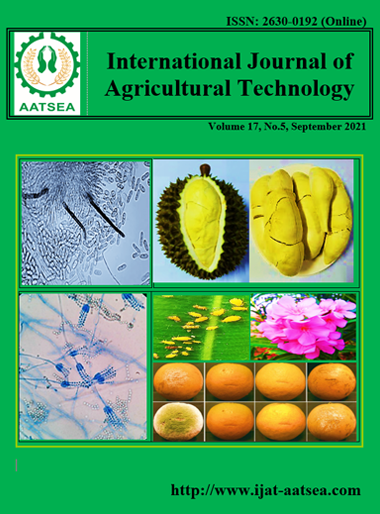Optimization and proximate analysis of prosomillet milk using response surface methodology
Main Article Content
Abstract
The milk extracted from plant-based sources is an upsurging fragment in augmenting new food products. The Minor Millet Proso(Panicummiliaceum L.) is a drought-resistant crop and well-provided nutrients such as dietary fiber, trace elements, and vitamins. The results depicted that soaking time, water for soaking, and extraction time had significantly affected on responses (p<0.05). The R2 for milk extracted, pH, and overall acceptability of the millet milk were 0.9475, 0.9017, and 0.9211 respectively. The results were considered as optimized values to obtain for soaking hours, water for soaking time, and extraction time with uppermost desirability index of 0.93was 12hours, 301ml, and 30minutes, respectively, while the optimal values for responses were milk extracted as 449.99ml, and pH6.43, Overall acceptability showed7.90.The experimental results recommended that the obtained model is accepted for the maximum yield of milk and enhanced density of the quality
Article Details

This work is licensed under a Creative Commons Attribution-NonCommercial-NoDerivatives 4.0 International License.
References
Aidoo, H., Sakyi-Dawson, E., Tano-Debrah, K. and Saalia, F. K. (2010). Development and characterization of dehydrated peanut-cowpea milk powder for use as a dairy milk substitute in chocolate manufacture. Food Research International, 43:79-85.
Bhat, S., Nandini, C., Tippeswamy, V. and Prabhakar (2018). Significance of small millets in nutrition and health-A review. Asian Journal of Dairy and Food Research, 37:35-40.
Bouis, H. E. (2000). Enrichment of food staples through plant breeding: A new strategy for fighting micronutrient malnutrition. Nutrition, 16:701-704.
Bunkar, D. S., Jha, A. amd Mahajan, A. (2014). Optimization of the formulation and technology of pearl millet based ‘ready-to-reconstitute’ kheer mix powder. Journal of Food Science and Technology, 51:2404-2414.
Chakraborty, S. K., Kumbhar, B. K., Chakraborty, S. and Yadav, P. (2011). Influence of processing parameters on textural characteristics and overall acceptability of millet enriched biscuits using response surface methodology. Journal of Food Science and Technology, 48:167-174.
Chattoraj, S., Sadhukhan, B. and Mondal, N. K. (2013). Predictability by Box-Behnken model for carbaryl adsorption by soils of Indian origin. Journal of Environmental Science and Health - Part B Pesticides, Food Contaminants, and Agricultural Wastes, 48:626-636.
Constantine, G., Seth, N., Chokshi, N., Minard, C. G., Guffey, D., Olive, A. P. and Davis, C. M. (2017). Combination Steroid and Test-based Food Elimination for Eosinophilic Esophagitis: A Retrospective Analysis. Journal of Pediatric Gastroenterology and Nutrition, 64:933-938.
Das, S., Khound, R., Santra, M. and Santra, D. K. (2019). Beyond bird feed: Proso millet for human health and environment. Agriculture (Switzerland), 9. https://doi.org/10.3390/agriculture9030064
Drake, M. A. (2007). Invited review: Sensory analysis of dairy foods. Journal of Dairy Science, 90:4925-4937.
Habiyaremye, C., Barth, V., Highet, K., Coffey, T. and Murphy, K. M. (2017). Phenotypic responses of twenty diverse proso millet (Panicum miliaceum L.) accessions to irrigation. Sustainability (Switzerland), 9:1-14.
Jha, A., Tripathi, A. D., Alam, T. and Yadav, R. (2013). Process optimization for manufacture of pearl millet-based dairy dessert by using response surface methodology (RSM). Journal of Food Science and Technology, 50:367-373.
Jusoh, J. M., Rashid, N. A. and Omar, Z. (2013). Effect of Sterilization Process on Deterioration of Bleachability Index (DOBI) of Crude Palm Oil (CPO) Extracted from Different Degree of Oil Palm Ripeness. International Journal of Bioscience, Biochemistry and Bioinformatics, 3:322-327.
Lifschitz, C. and Szajewska, H. (2015). Cow’s milk allergy: evidence-based diagnosis and management for the practitioner. European Journal of Pediatrics, 174:141-150.
Lim, J. (2011). Hedonic scaling: A review of methods and theory. Food Quality and Preference, 22:733-747.
Luo, Y., Li, B., Ji, H., Ji, B., Ji, F., Chen, G. and Tian, F. (2009). Effect of soaking and cooking on selected soybean variety for preparation of fibrinolytic Douchi. Journal of Food Science and Technology, 46:104-108.
Mäkinen, O. E., Wanhalinna, V., Zannini, E. and Arendt, E. K. (2016). Foods for Special Dietary Needs: Non-dairy Plant-based Milk Substitutes and Fermented Dairy-type Products. Critical Reviews in Food Science and Nutrition, 56:339-349.
McSweeney, M. B., Seetharaman, K., Ramdath, D. D. and Duizer, L. M. (2017). Chemical and physical characteristics of proso millet (Panicum miliaceum)-based products. Cereal Chemistry, 94:357-362.
Nithiyanantham, S., Kalaiselvi, P., Mahomoodally, M. F., Zengin, G., Abirami, A. and Srinivasan, G. (2019). Nutritional and functional roles of millets—A review. Journal of Food Biochemistry, 43:1-10.
Punniyamoorthy, S. (2018). Development and evaluation of fermented millet milk based curd Development of functional fermented millet based for combating vitamin B12 deficiency View project. Journal of Pharmacognosy and Phytochemistry, 7:714-717.
Sadhukhan, B., Mondal, N. K. and Chattoraj, S. (2016). Optimisation using central composite design (CCD) and the desirability function for sorption of methylene blue from aqueous solution onto Lemna major. Karbala International Journal of Modern Science, 2:145-155.
Said, K. A. M., Yakub, I. and Amin, M. A. M. (2015). Overview of Response Surface Methodology (RSM) in Extraction Process. April, 279–287. https://doi.org/10.3850/978-981-09-4587-9_p38
Saleh, A. S. M., Zhang, Q., Chen, J. and Shen, Q. (2013). Millet grains: Nutritional quality, processing, and potential health benefits. Comprehensive Reviews in Food Science and Food Safety, 12:281-295.
Sankar, R., Pandav, C. S. and Sripathy, G. (2008). Ethics and public health policy: Lessons from salt iodization program in India. Comprehensive Reviews in Food Science and Food Safety, 7:386-389.
Sethi, S., Tyagi, S. K. and Anurag, R. K. (2016). Plant-based milk alternatives an emerging segment of functional beverages: a review. Journal of Food Science and Technology, 53:3408-3423).
Shen, R., Ma, Y., Jiang, L., Dong, J., Zhu, Y. and Ren, G. (2018). Chemical composition, antioxidant, and antiproliferative activities of nine Chinese proso millet varieties. Food and Agricultural Immunology, 29:625-637.
Shunmugapriya, K., Kanchana, S., Maheswari, T. U., Kumar, R. S. and Vanniarajan, C. (2020). Standardization and Stabilization of Millet Milk by Enzyme and Its Physicochemical Evaluation. European Journal of Nutrition & Food Safety, 30-38.
Wang, H. L., Swain, E. W., Hesseltine, C. W. and Heath, H. D. (1979). Hydration of Whole Soybeans Affects Solids Losses and Cooking Quality. Journal of Food Science, 44:1510-1513.


